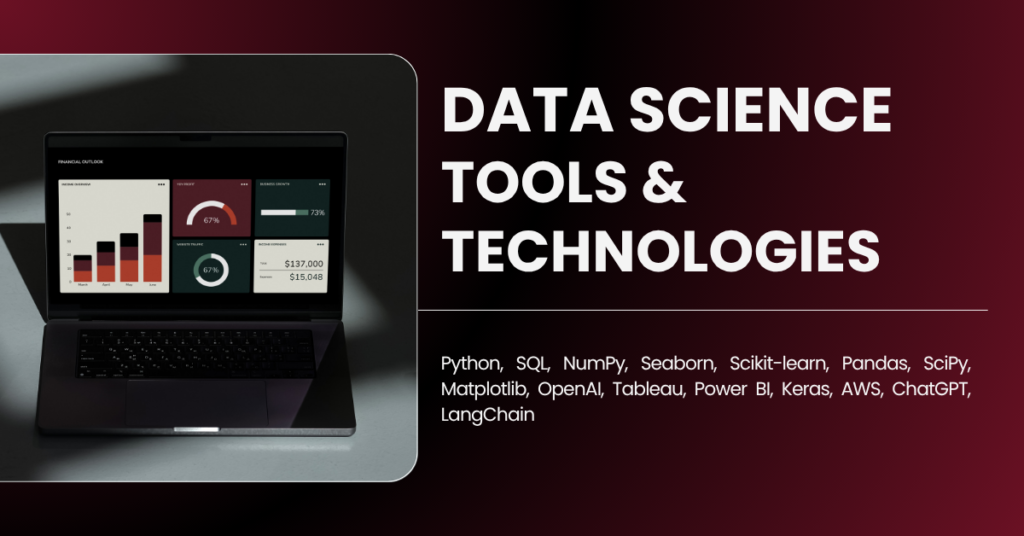Top Data Science Tools to Master in 2025
Most learners start with Python or SQL but soon get stuck when asked about real-world projects, model deployment, or data visualization in interviews.
Why? Because data science is not about one tool. It’s a combination of skills and technologies that work together from collecting and cleaning data to visualizing results and deploying models.
In this blog, you’ll discover the most in-demand data science tools in 2025, learn what each one does, why it’s important, and how it fits into a real data science workflow.
What Are Data Science Tools?
Data science tools are programming languages, libraries, frameworks, and platforms used for:
- Cleaning and transforming data
- Performing statistical and machine learning tasks
- Creating visualizations and dashboards
- Storing, accessing, and managing data on the cloud
- Building and deploying AI models
Whether you’re a fresher or a professional, using the right tools makes your workflow faster, cleaner, and job-ready.
Top 10 Data Science Tools
1. Python
Python is a versatile programming language that is widely used in data science for scripting, machine learning, and automation.
Features:
- Easy-to-read syntax and beginner-friendly
- Huge collection of libraries (NumPy, Pandas, Scikit-learn, etc.)
- Open-source and highly flexible
- Integrates well with web and cloud platforms
Why Python in Data Science?
Python is considered the foundation of the data science tech stack. Whether you’re building data pipelines or training machine learning models, Python is almost always involved.
2. SQL
SQL (Structured Query Language) is used to communicate with, manage and manipulate relational databases.
Features:
- Easy syntax to fetch and filter data
- Supports joins, aggregations, and nested queries
- Industry standard for working with structured data
Why SQL in Data Science?
Data scientists spend a lot of time querying databases to prepare data. SQL is essential for feature engineering, data extraction, and analysis in real-world projects.
3. Pandas
Pandas is a Python library for data manipulation and analysis.
Features:
- Provides DataFrames and Series for tabular data
- Functions for filtering, grouping, and joining data
- Built-in functions for handling missing data
Why Pandas in Data Science?
It’s the go-to tool for data preprocessing. From Excel files to SQL queries, Pandas helps clean and structure your data for analysis or modeling.
4. NumPy
NumPy is a core scientific computing package in Python, focused on numerical operations.
Features:
- N-dimensional array object
- Broadcasting ,vectorized operations, and mathematical functions
- Foundation for libraries like Pandas, SciPy, and Scikit-learn
Why NumPy in Data Science?
NumPy ensures fast computation, making it ideal for handling large datasets, performing mathematical operations, and preparing features for machine learning.
5. Seaborn & Matplotlib
Matplotlib is a plotting library, while Seaborn is built on top of it for easier, more beautiful visualizations.
Features:
- Create line, bar, scatter, and heatmap plots
- Customizable themes and styles
- Seamless integration with Pandas
Why Visualization in Data Science?
Communicating results is as important as computing them. These libraries help you tell a visual story that business stakeholders can understand.
6. Scikit-learn
Scikit-learn is a machine learning library for Python, offering simple and efficient tools for data mining and analysis.
Features:
- Pre-built models for classification, regression, clustering
- Model selection, validation, and evaluation modules
- Works well with Pandas and NumPy
Why Scikit-learn in Data Science?
It’s the first stop when building machine learning models. Clean API and great documentation make it perfect for beginners.
7. SciPy
SciPy is a Python library used for scientific and technical computing.
Features:
- Modules for statistics, optimization, and signal processing
- Built on NumPy for high performance
- Often used in academic and engineering applications
Why SciPy in Data Science?
For advanced math operations or custom statistical methods, SciPy is extremely useful.
8. Tableau
Tableau is a business intelligence and data visualization tool used to create interactive dashboards.
Features:
- Drag-and-drop interface
- Connects with SQL, Excel, cloud databases
- Used for real-time data reporting
Why Tableau in Data Science?
It bridges the gap between technical data scientists and non-technical stakeholders through storytelling with data.
9. Power BI
Power BI is a Microsoft business analytics tool that provides interactive visualizations and business intelligence capabilities.
Features:
Integrates easily with Microsoft products (Excel, Azure)
Built-in AI visuals and natural language Q&A
Publish reports to the web or mobile apps
Why Power BI in Data Science?
Power BI is used extensively in enterprises for dashboarding and analytics. If you work in a Microsoft ecosystem or serve corporate clients, learning Power BI is a valuable asset.
9. OpenAI & ChatGPT
OpenAI is an AI research lab. ChatGPT is a conversational AI model developed by OpenAI.
Features:
- Generate text, write code, summarize data
- API access for integration into apps
- Used in automation and research workflows
Why ChatGPT in Data Science?
From writing code snippets to generating documentation, ChatGPT accelerates data science workflows.
10. LangChain
LangChain is an open-source framework designed to simplify the development of applications powered by large language models (LLMs).
Features:
Modular and composable components
Easily integrate OpenAI models
Popular in building AI-powered agents
Why LangChain in Data Science?
It lets you create intelligent apps using models like ChatGPT, making your solutions smarter and context-aware.
11. AWS S3 & AWS Services
AWS S3 is a cloud storage service by Amazon Web Services.
Features:
Store large datasets securely
Highly scalable and cost-effective
Integrates with AWS analytics and AI tools
Why AWS in Data Science?
Data scientists use AWS S3 for storing and retrieving training data, and services like EC2 and SageMaker for building and deploying models.
Summary Table of Top Data Science Tools
| Tool | Purpose | Why It Matters |
|---|---|---|
| Python | Programming Language | Base for all DS & ML tasks |
| SQL | Database Query Language | Essential for retrieving and manipulating structured data |
| Pandas | Data Manipulation Library | Preprocess and clean data |
| NumPy | Numerical Computation | Fast math operations |
| Seaborn | Visualization Library | Make professional plots easily |
| Scikit-learn | Machine Learning Library | Build ML models fast |
| SciPy | Scientific Computing | Perform advanced math/stats |
| Tableau | Data Visualization Tool | Build dashboards and share insights |
| Power BI | Business Intelligence Tool | Visualize and share reports interactively |
| OpenAI | AI Model Platform | Use ChatGPT for automation |
| LangChain | LLM App Development Framework | Build smart AI-powered tools |
| AWS S3 | Cloud Storage | Store/manage data at scale |
Conclusion: Build Future-Proof Data Science Skills
Mastering the right data science tools isn’t just about passing interviews, it’s about solving real problems, building real projects, and growing confidently in your career.
From Python and SQL to Power BI, Tableau, ChatGPT, and LangChain, each tool has a vital role to play in today’s data ecosystem.
But learning all these tools by yourself can be overwhelming. INTTRVU.AI’s Data Science & AI Certification Program helps you learn every tool you need from basics to advanced through hands-on projects, mock interviews, and career mentorship.
Explore the program at INTTRVU.AI today and start mastering the tools that matter.
FAQs
A: Start with Python and SQL. These two tools are foundational and open doors to using other advanced libraries.
A: ChatGPT is used for code generation, summarization, automation, and documentation in data workflows.
A: Tableau is great for building dashboards and sharing insights with non-technical teams.
Lorem ips
A: Yes, AWS S3 helps store and manage large datasets in production environments.
um dolor sit amet, consectetur adipiscing elit. Ut elit tellus, luctus nec ullamcorper mattis, pulvinar dapibus leo.
A: LangChain is a framework that helps you build applications using models from OpenAI like ChatGPT.



